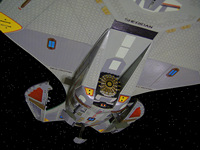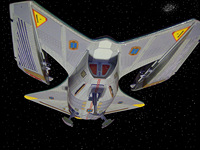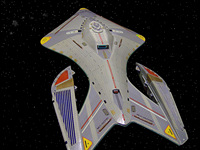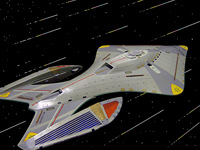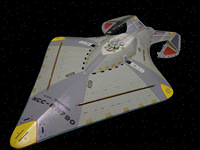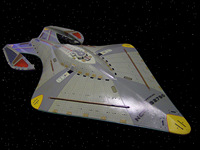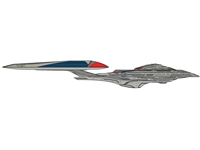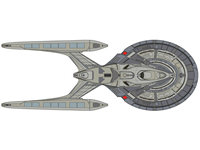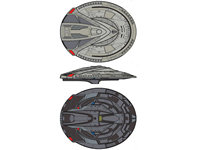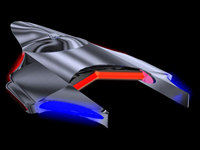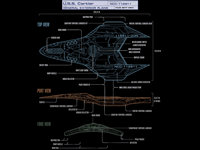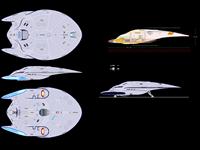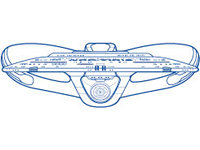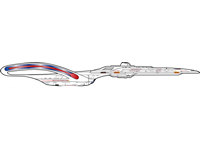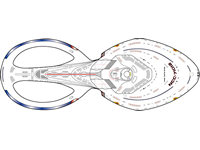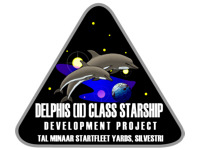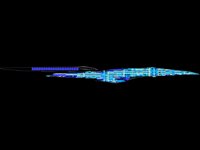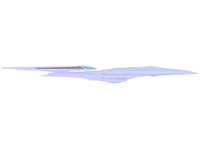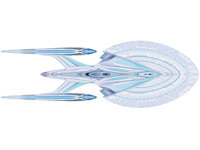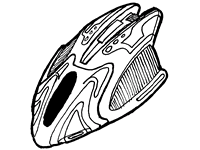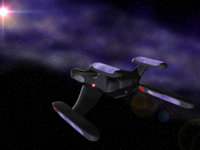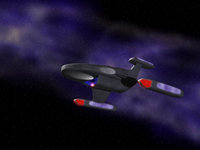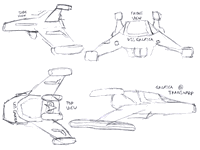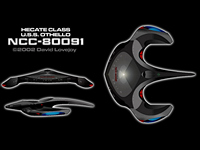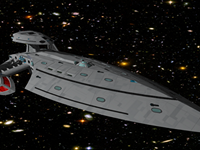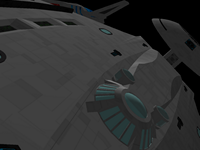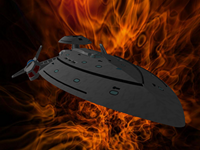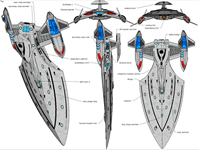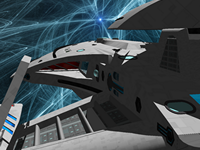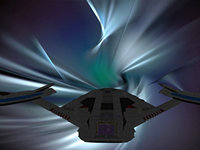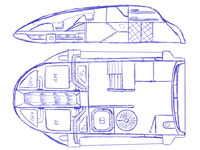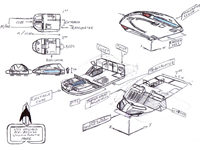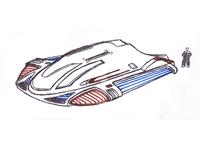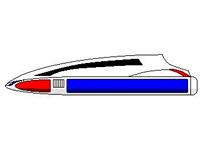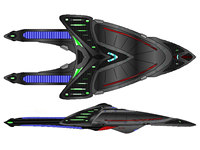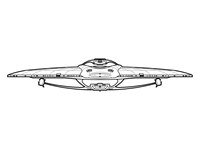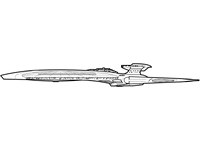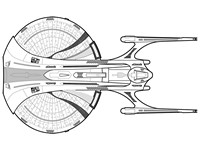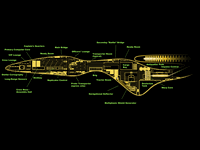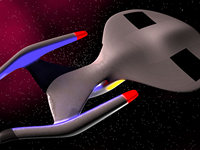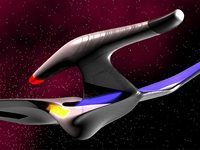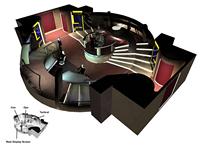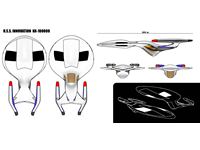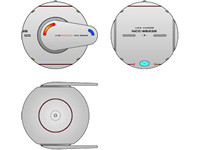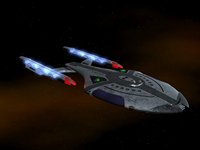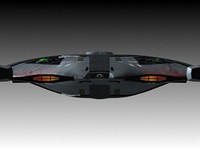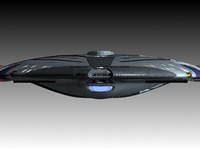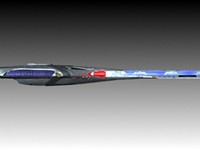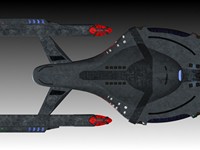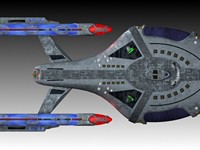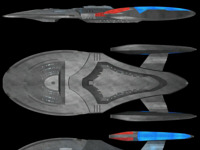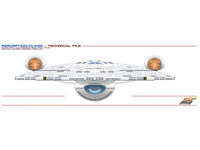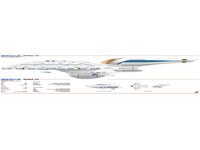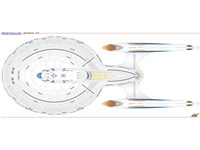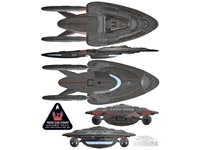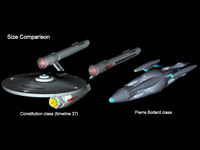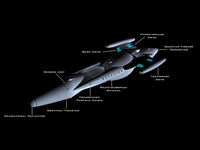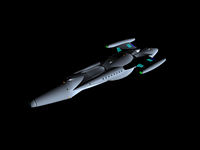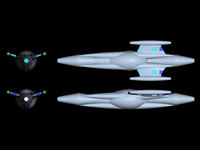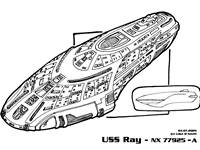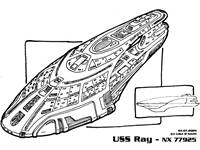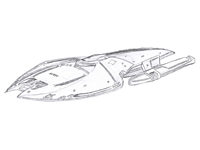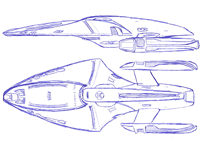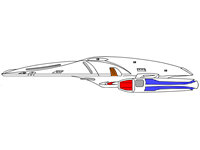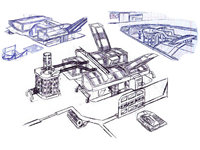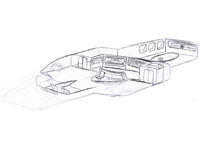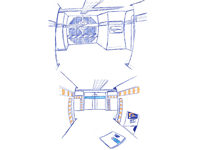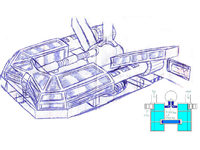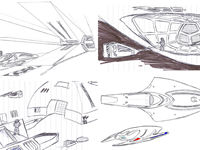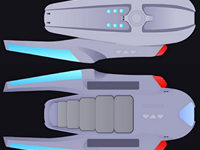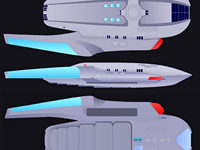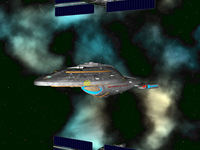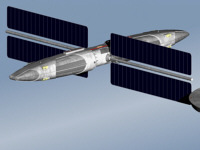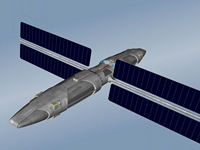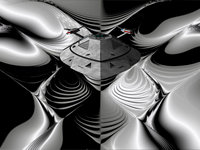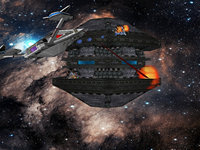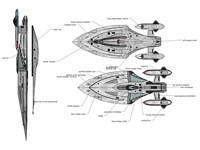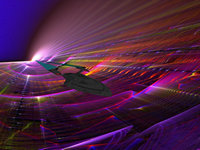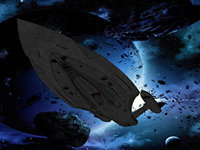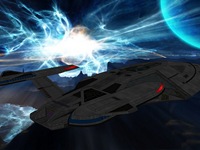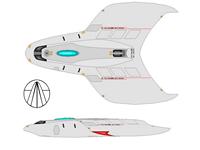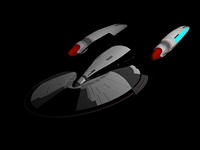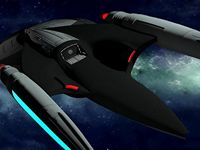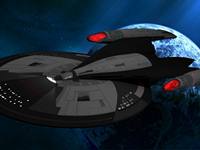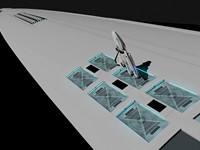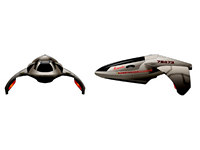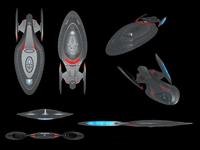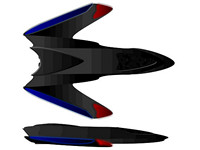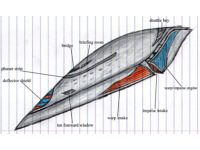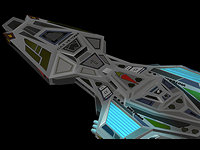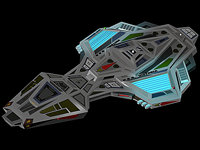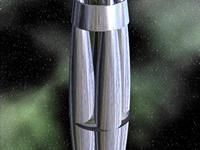Future Starships & Design Studies
Other Designs, Alien Starships, Future Starships & Design Studies, Abramsverse Designs
Apogee Class
Design by Michael Zurek
Type: Explorer
First commissioned: 2432
Length: 338.7m
Width: 130m
Height: 63m
Decks: 14
Displacement: 650000t
Complement: 24 officers + 108 crew
Speed: Warp 9 (cruise), Warp 9.90 (max.), Warp 9.923 (max. emergency)
Sublight speed: 0.65c (max.)
Armament: 12 type x-5 collimated quantum phaser arrays, 4 mk-100 direct fire quantum torpedo tubes (2 forward, 2 aft)
Defense: fs md-12 regenerative mult-layer shields, cx-01 ablative armor grid, ac-4 adaptive camouflage grid
Embarked craft: 4 shuttlecraft, 2 workpods, 1 aeroshuttle
In the early 25 century Starfleet began designing a replacement for the aging Intrepid class ship. After years of studying the sensor logs brought back from the Delta Quadrant a design was excepted. Designated the Apogee class the first shakedown run in 2428 proved very successful, boasting high warp capabilities. With Borg influenced sensors and improved planetfall systems, the first vessel went into service in 2432. The U.S.S.Apogee NX-82710 paved the way for nine more vessels of this class to be built:
- U.S.S.Valor NCC-82720
- U.S.S.Akron NCC-82730
- U.S.S. Shelby NCC-82740
- U.S.S.Solaris NCC-82750
- U.S.S.Pinnacle NCC-82760
- U.S.S. La Grange NCC-82770
- U.S.S. Providence NCC-82780
- U.S.S. Sheridan NCC-82790
Atlas Class
Design by Alec
Type: Deterrence explorer/diplomatic cruiser
First commissioned: 2390
Length: 1008m
Width: 366m
Height: 144m
Decks: 40
Displacement: 5600000t
Complement: 54 officers + 1456 crew, evacuation limit: 4140
Speed: Warp 7.5 (cruise), Warp 9.2 (max.), Warp 9.5 (max. emergency)
Sublight speed: 0.45c (max.)
Armament: 14 Type-XII phaser arrays, 4 point defense dual phaser arrays, 3 point defense phaser arrays, 1 Atlas-type revolving six-barrel quantum torpedo magazine (dorsal) with 850 quantum torpedoes, 1 rapid fire quantum torpedo turret (ventral) with 750 quantum torpedoes, 6 burst fire quantum torpedo bays with 100 quantum torpedoes each, anti-Matter spread emitter
Defense: High-impact auto-modulated quad-matrix shield system (8,250,000 terajoule), heavy tetraburnium double hull plus 15cm high density ablative armor, ablative armor generators, high level structural integrity field
Embarked craft: 2 Danube-class runabouts, 2 Venture-class runabouts, 5 Type-9 personnel shuttles, 5 Type-10 cargo shuttles, 1 Argo-class runabout, 2 custom runabouts or 6 custom shuttles, 1 captain's yacht
The Atlas-E class, which is the finalized Atlas class was created in response to a need for a powerful capital vessel with the firepower and defenses to enable it to face off against enemy dreadnaught type vessels at a diminished disadvantage. A ship that could also double as a diplomatic platform as well as an apparatus of deterrence. The most noticeable feature of the Atlas class is the Atlas-S class separation saucer that is imbedded into the Atlas's main saucer.
Atlas-S Class
Design by Alec
Type: Escape vehicle/multi-purpose mobile headquarters
First commissioned: 2390
Length: 214m
Width: 170m
Height: 52m
Decks: 15
Displacement: 241280t
Complement: 11 officers + 137 crew, evacuation limit: 1540
Speed: Warp 2.8 (cruise), Warp 3.9 (max.), Warp 6.0 (max. emergency)
Sublight speed: 0.55c (max.)
Armament: 3 Type-XI phaser arrays (total output 65,000 TW), 1 Atlas type revolving six-barrel quantum torpedo magazine with 850 quantum torpedoes, anti-Matter spread emitter
Defense: High-impact auto-modulated unimatrix shield system (5,565,000 terajoule), heavy tetraburnium double hull plus 15 cm high density ablative armor, medium level structural integrity field
Embarked craft: 2 Danube-class runabouts
The Atlas-S class is not really a ship of itself, but rather a separable saucer unit that belongs to the Atlas-class cruiser. When it is separated, due to possible evacuation of its mothership, it is fully autonomous, but lacks effectual range due to its lacking speed. It however does possess its own deflector array, contains three of the Atlas-class's phaser arrays and has the Atlas-class's revolving six-barrel quantum torpedo magazine. Due to its integration with the Atlas, it also inherited part of its rather heavy defensive and armor capabilities. It still possesses sufficient space and emergency evacuation accommodations to house and protect the Atlas's entire crew. It is possible that Starfleet will launch a more autonomous version of the Atlas-S later in time, due to its untapped potential as a mobile headquarters for Starfleet operations.
Cartier Class
Design by Nick
No specs available
No description
Constable Class
Design by Phil Sherman
Type: Corvette
First commissioned: 2430
Length: 181m
Width: 114m
Height: 33m
Decks: 11
Displacement: 135000t
Complement: 20 officers + 50 crew, evacuation limit: 200
Speed: Warp 8.5 (cruise), Warp 8.9 (max.), Warp 9.2 (max. emergency)
Sublight speed: 0.8c (max.)
Armament: Phalanx torpedo launcher system
Defense: Networked phaser grid, trans-phasic shielding system
Embarked craft: 2 modified Tiberius class shuttles
The Constable class star ships or corvettes are designed for patrol and station/planetary defense. The Constable class patrol ship is usually deployed in groups of 3, to allow multi vector capabilities. Conditions on the Constable class are adequate for comfortable living, but by no means as luxurious as some of the larger vessels. Some things had to be sacrificed due to space requirements, but there is one holo-deck for recreation.
Cruise warp of the Constable class corvette is 8.5; however the ship is also equipped with trans-warp-conduit drive (TWCD) allowing her move vast distances in just a few minutes. The TWCD is a proto-type; therefore it is not the main form of FTL travel. The TWCD is only used on an 'as needed' basis, usually during crisis/emergency situations.
The main offensive weapon of the Constable class is her torpedo launcher. The Phalanx can fire a burst of up to 6 torpedoes per second. A standard, full volley is a 2 second burst of 12 torpedoes, but the maximum torpedoes that can be fired during a single forward volley is 36. During situations of aggression, such as war, she can be loaded with a maximum of 400 torpedoes. 80 of the more powerful quantum torpedoes are usually on hand for the really tough situations, but, if it is deemed needed, the Captain and at least one of his senior officers (or 2 of the senior officers if the Captain is incapacitated), can deploy the most deadly of torpedoes. The Phased Photon Torpedo (PPT) has an internal phasing device, which phases it out of normal space and can be used in one of two ways. Firstly, it can be programmed to run on internal power and phase back into space at a specific point, such as an enemy vessels warp core. But this is only useful against slow vessels or stationary targets. Secondly, when launched, the torpedo extends temporal coils approximately 15mm outside of its shell, it is also charged with an energy pulse which feeds the phasing device via the coils. The torpedo phases out of normal space leaving the coils in transition, half in normal space, half phased. When the torpedo comes in contact with shields, the temporal coils and the energy pulse are sheared off, leaving the torpedo to phase back into normal space just in time to slam into the hull. If no shields are up, then the coils and pulse are sheared off on the hull, and the torpedo phases back inside of the target.
The Type XII phaser arrays are standard planetary defense phasers, adapted for starship use, the output is roughly 6000 terawatts. These phaser arrays have the Reaper (AAF) system installed on them. When the Reaper system is engaged, the phasers will auto acquire and fire on any target within range, which does not have a "friendly" signature. The system is designed to defeat incoming torpedoes.
The primary defense system is the Nanite repair systems (NRS) are automatically activated if the damage to the armor dips below 80%, which substantially lessens the rate of degradation under fire, but takes time to repair the panels (roughly 25% per hour max.); however, nanites can be diverted from other sections to augment and speed the process.
The maximum absorption of the metaphasic shielding is 18000 joules per emitter, with 5000 joules per minute regenerative rate. There are 11 primary emitters, 11 secondary and 3 supplemental emitters on each ship. The supplemental emitters augment the forward weapons, shuttle bay, and engineering sections to add extra protection.
Torsten designed the original Tiberius shuttle, which was modified for use in this ship.
Delphis (II) Class
Design by Michael Dugas
Type: Large exploratory cruiser (CKE)
First commissioned: 2384
Length: 717m
Width: 275m
Height: 80m
Decks: 26
Displacement: 4390000t
Complement: 145 officers + 455 crew, evacuation limit: 5700
Speed: Warp 9.20 (cruise), Warp 9.90 (max.), Warp 9.985 (max. emergency)
Sublight speed: 0.95c (max.)
Armament: Type XII phaser ring; Type XV pulse phaser cannon; Mk 80 photon torpedoes; Type IV quantum torpedoes
Defense: CIDSS-5 deflector; FSQ-4 shields; FPCE-2 cloaking technology
Embarked craft: runabouts (2), shuttles - cargo (5), shuttles - personnel (5), shuttlepods (10), Valkyrie fighters (12)
The Delphis (II) class cruiser was developed as one of the possible classes to succeed the Galaxy class cruiser as the flagship the fleet. It was developed jointly with the Nova, Intrepid, and Sovereign classes. Incorporating a revolutionary warp nacelle design, the Delphis (II) class embraced the concepts of the variable geometry warp drive, without the vulnerabilities of having to move the actual warp nacelles.
With the selection of the Sovereign class as the newest USS Enterprise, and the successful trials of the Intrepid class, the Delphis project was quickly falling out of the race. The destruction of the first Delphis class ship, the USS Delphis [NX 71000] during spaceframe trials was the final blow against the project. However, the ASDB had almost completed the second spaceframe [NX 71001] and was given the green light to complete and test the vessel. The first operational Delphis class ship, USS Alexandretta [NCC 71001] was quietly commissioned and completed her initial 2 year shakedown cruise before being lost in the Gamma Quadrant. The ASDB developed a second ship for additional testing, USS White Star [NX 71012]. The White Star was commissioned and has been serving Starfleet with honor.
Enterprise Study
Design by Steven Haack
NCC-1701 (commemorative, preliminary designation)
The Enterprise as a proposed design and is the culmination of many schools of thought within the Federation and Starfleet. If developed, her role would fill an expanding void between the quest for knowledge which has been synonymous with the Federation since its inception, and the need for effective defensive capabilities. With recent incursions within Federation space and surrounding its borders, it has become increasingly difficult to focus on pure exploration. The Enterprise would be built to re-emphasize Starfleet's role as an organization of peace.
Many within Starfleet have objected to the use of a Sovereign Class vessel as the Federation flagship and consider it "too aggressive" with its obvious design objective being that of a "defensive workhorse". Indeed, it has been thought that a new design will someday be required to
properly showcase the benevolent mission of Starfleet. Engineers and designers project that this vessel, if completed would replace the Sovereign class Enterprise within 15-20 years. A development project was soon begun, with the focus being:
- Design a vessel integrating all the latest technology, especially that acquired by Voyager while in the Delta quadrant.
- Re-integrating crew family accommodations for long missions.
- A vessel large enough to house multiple research facilities (perhaps the largest amount ever placed on a Starfleet vessel).
- A vessel with low-profile weaponry, equipped with low "stealth" energy signatures.
- Shielding capable of withstanding heavy attack, without necessarily using methods of "hostile engagement".
Flux Class
Design by Robert Kernke
No specs available
No description
Galatea Class
Design by Rob
No specs available
This is a warship, designed in the treaty of the Borg, Klingons, and Federation in an attempt to stop Species 8472 in the year 2599.
Hecate Class
Design by David Lovejoy
Type: Scout/escort
Length: 183m
Beam: 200m
Height: 60m
Decks: 6 (+2 maintenance tubes)
Crew complement: 81
Max. speed: Warp 9.997 (for 6 hrs)
No description
Heret Class
Design by Noah
Type: Presidential transport / explorer
First commissioned: 2459
Length: 173m
Width: 97m
Height: 35m
Complement: 22 officers + 61 crew, evacuation limit: 300
Speed: Warp 8.5 (cruise), Warp 9.82 (max.), Warp 9.983 (max. emergency)
Sublight speed: 0.76c (max.)
Armament: 3 type-XV, 6 type-X, 2 torpedo turrets, 1 torpedo launcher
Defense: ablative armor, MLSS and double tritanium hull
Embarked craft: 1 executive class runabout and 4 evacuation shuttles in auxiliary shuttle bays
The Heret class is named after an Egyptian goddess whose name means, "She who is above the spirits", clearly indicating her dominating force in the afterlife.
During the Dominion War and the Changeling scare on Earth the need was realized for a starship that could safely transport the president to any area of space in an emergency as well as a small multi purpose starship with enhanced defensive systems. Such a vessel would have to be very small, well armed, even better armored and equipped with unique advancements that allow it to serve as a mobile command center.
A request for a design was sent out to all the major shipyards and one was accepted. When using the sensor disruptor the executive class operates solely on the singularity. It incorporates Borg technology as well with ablative armor and stellar cartography. It is equipped with three type XV and six type X phasers as well as 2 torpedo turrets and 1 torpedo cannon. As a diplomatic starship it has two briefing rooms and two observatories as well as an extensive encryption network. The massive energy consumption used by the ship's systems is supplied by a hybrid warp core and quantum singularity as a presidential escort the shields are double layered and the ablative armor is double that used on Sovereign class vessels when deployed. A sensor disruptor was developed singularly for this vessel using captured Borg, Romulan and Dominion devices.
Another unique technology developed for the class was a type of holo-projector system that can project an entire fleet of Federation ships or a field of debris that makes it seem like the Heret has been destroyed. The Heret uses these two systems in conjunction to fool enemy ships. The Heret also uses probes equipped with these technologies to send ships away from the Heret class vessel while at warp speed. These systems however are not always adequate to ward off enemy forces, because the fake ships simply appear out of thin space if the enemy takes tabs of the federation forces they will notice the rapid appearance of a fleet and thus realize that the fleet is a fake.
Holland Class
Design by BorgMan, description by USS Paladin
Proposed: 2402
Commissioned: 2409
Length: 22m
Height: 4.5m
Width: 4.5m
Crew: 1-4, max. evacuation capacity of 30
War speed: Warp 9.2 (max.), Warp 8.3 (max. cruise), Warp 6 (cruise)
Armament: 1x micro quantum torpedo launcher (fore), 4x Type-VII phaser arrays (2x ventral, 2x dorsal)
The Holland replaced the long-lived Danube as Starfleet's Runabout of choice. Slightly smaller but much more capable than its predecessor, the Holland reaches new heights in terms of speed, firepower, and efficiency. The design phase lasted 6 years, a long time for a small craft. Twenty prototypes were produced and tested rigorously for over a year, and the class was fully certified in 2409.
The interior is laid out so as to maximize usable space. Crammed into the craft is a small bridge, storage closet and armory, lavatory, four small bunks, a replicator, and a transporter. The ship is not altogether dissimilar to the Delta Flyer in terms of interior arrangement. The ship can reach a blistering (for a shuttlecraft) top speed of Warp 9.2, with a maximum sustainable cruise of Warp 8.3. Normal cruise speed is a respectable Warp 6. Sublight speed is significantly better than the Danube, and maneuverability is improved thanks to the Holland's more compact, integrated shape. In the event of an overload, a section of the nose can pop off, and the warp core may be ejected. A quarter of Type-VII phaser arrays, 2 mounted on the ship's back and the other two on its underside provide primary defense, with a single micro Quantum torpedo launcher recessed in a panel in the nose. Regenerative shielding protects the craft, though its best defense against larger ships is its speed and small size.
Unlike the Danube, the Holland is not capable of mounting mission specific packages. However, the general purpose craft is capable of easily realigning its sensors or integrating small additions to its sensor package. The main computer core can house two additional memory blocks or a full four gel packs for storage space or needed computer processing power, respectively.
Incursion Class
Design by Capt. W. Harris
Type: Heavy cruiser
Length: 370m
Height: 59m
Deck count: 14
Crew complement: 30 officers; 90 enlisted
Power Plant: one 8,500+
cochrane quantum induction core feeding two nacelles; 10 Class-VIII impulse fusion power plants
Speed: 9,800 m/s^2 (sublight); Warp 9.5 (cruise); Warp 9.98 (maximum); Warp 9.9905 for 36 hours (burst); 160,000 TSL (slipstream)
Armament: 6 Type-14 heavy phaser arrays; 10 Type-12 phaser arrays; 5 Class-VI burst-fire torpedo launchers; 900 quantum torpedoes; 20 transphasic torpedoes;
Defense: regenerative shields (10.0 exajoules); ablative armor (21.0 centimeters)
Special technology: Borg transwarp drive, enhanced impulse engines, adaptive shields
The Incursion-class vessel was commissioned by Starfleet Intelligence as a testbed of captured Borg technology in the aftermath of the Collective's destruction.
Independence Class
Design by Sam Kowal
Type: Enhanced deterrence explorer
First commissioned: 2517
Length: 794m
Width: 478m
Height: 98m
Decks: 14
Displacement: 5333000t
Complement: 350 officers + 1100 crew, evacuation limit: 18000
Speed: QV 3 (cruise), QV (max.), QV 4.95 (max. emergency)
Sublight speed: 0.9999c (max.)
Armament: 10x Type XV monophasic emitters, 4x graviton torpedo launchers, 4x transphasic torpedo launchers, polaron beam emitter
Defense: Chronophasic shield generator (Capacity 5,312,000,000 terajoules), yiterium hull, 1cm tribaltic armor, polaric molecular bond enhancer
The Independence class starship was introduced on Stardate 194038.35. Increased concerns of confrontation with the "Sphere Builders" forced Starfleet to testbed many new technologies in the Independence class. With the loss of the Enterprise-H in a skirmish with the Seronites, Starfleet approved the commission of the second Independence class starship, the USS Enterprise, NCC-1701-I on Stardate 194586.19. The Enterprise and her sister ship, the USS Independence NX-307781 (registry later changed to NCC), were out fitted with the new technology, including the newly developed
Chronophasic shielding: Upon impact, these shields spread damage out over not only the physical area of the shield but across time, and across several phases, significantly reducing the load on the shield.
Yterium: Modern crystalline metal developed by Starfleet Quantum Mechanics department. Element no. 174.
Tribaltic armor: Incredibly dense boson condensate, and incredibly resilient to change in state, a single cm of the armor will dissipate the energy of an attack across the entire hull.
Polaric bond enhancer: Essentially an ultra-SIF that works on a much much finer level, increasing the bond between the subatomic particles that make up atoms.
Quantum drive: A new generation of quantum slip stream drive, allows the ship to travel at unimaginable speeds. The invention of the quantum drive several decades earlier, caused for a new warp scale to become employed.
QV stands for Quantum Velocity:
QV 1 = Warp 9.9
QV 2 = Warp 9.99
QV 3 = Warp 9.999
QV 4 = Warp 9.9999
QV 5 = Warp 9.99999
QV 6 = Warp 9.999999
QV 7 = Warp 9.9999999
QV 8 = Warp 9.99999999
QV 9 = Warp 9.999999999
Despite being labeled an enhanced deterrence explorer, the ships secondary mission is more militaristic, so the ship is complemented by Starfleet's finest weaponry including most notably the graviton torpedo. This device works by disrupting the gravitons in an enemy vessels hull, causing the ship to come apart at a subatomic level. This ship represents the finest Starfleet has to offer. May it soar many long years exploring our universe, and defending the Federation's citizens, and the freedoms they enjoy.
Innovation Class
Design by Chris
Type: Explorer
Length: 500m
Speed: Warp 9.97 (cruise, 4956c); Warp 9.995 (max., 19910c)
Crew: 450
The Innovation is a post-TNG era exploration, research, and rescue vessel. Much of her basic theory was developed during the 2360s, but actual construction didn't begin until the late 2380s. The return to Federation Space of the U.S.S. Voyager also stimulated a number of starship breakthroughs, and the Innovation is the beneficiary of much of this research.
Kamome Class
Design by EMH
Speed: Warp 9.9 (max.)
Crew complement: 130
No description
Laninia Class
Design by GIB
Length: 720m
Width: 260m
Height: 60m
Weapons: 10 phaser banks, 1 front phaser cannon, 2 front and aft quantum torpedo launchers
1 pair of interdimensional gate generators, dimensional stabilisation grid
This is a design study of a ship that may be built when the technology for interdimensional travel will be available (breakthrough expected after 2400).
Mephistopheles Class
Design by Paul Weaver
Type: Tactical explorer
First commissioned: 2415
Length: 688m
Width: 275m
Height: 92m
Decks: 21
Displacement: 3,135,000t
Complement: 65 officers + 340 crew, evacuation limit: 6800
Speed: Warp 9.79 (cruise), Warp 9.89 (max.), Warp 9.99 (max. emergency)
Armament: 12 type 12 heavy phaser arrays, 3 class-VI rapid-fire pulse phaser cannons (2 fwd, 1 aft), 1200 quantum torpedoes, 15 transphasic torpedoes, 4 Class IX burst-fire torpedo launchers (2 fwd., 2 aft)
Defense: Regenerative energy shields (9.5 exajoules), ablative hull armor (6 cm), secondary shields (4.0 exajoules), 1 class-III cloaking generator
Embarked craft: 4 type G2 shuttlecraft
In the aftermath of the Dominion War, Starfleet increased production on tactical vessels ten-fold. The Mephistopheles class was originally pitched to Starfleet R&D by a team of engineers serving aboard Utopia Planitia in 2382, but was passed over in favor of several other, less ambitious vessels, none of which ever went beyond their initial stages of development. It wasn't until the early 25th century that the Mephistopheles class was given another look. In 2407, the it was brought up during a tactical brainstorming session on Jupiter Station. One of the engineers who had designed the vessel was, by that time, a high-ranking Admiral, and immediately ordered the specs updated to be brought up to 25th century standards. It took less than six months before the final specs were delivered to Starfleet R&D for a series of intense simulations testing the many theories behind the vessel. As these tests progressed, the Mephistopheles class underwent several changes, mostly in its structural build. The prototype U.S.S. Mephistopheles was launched for shakedown flights in 2415, and was officially cleared for active duty just six months later. The Mephistopheles class was officially pressed into extended production in mid-2416. Their numbers have risen quickly, as is evident by the over two-dozen currently in service.
This ship appears in the fan fic Star Trek Frontiers.
Perception Class
Design by Josheua Samuelson
Type: Enhanced diplomatic explorer
First commissioned: 2401
Length: 1100m
Width: 443m
Height: 121m
Decks: 26
Displacement: 7300000t
Complement: 450 officers + 1200 crew, evacuation limit: 24000
Speed: Warp 8 (cruise), Warp 9.9 (max.), Warp 9.98 (max. emergency)
Sublight speed: 0.75c (max.)
Armament: 15x Type XIV phaser banks, 10x torpedo launchers (6 forward, 4 aft), 3x Generation 1 field model phased energy canon, 20x point defense pulse phasers
Defense: Dual layer regenerative shielding, 20cm ablative hull armor, 40cm deployable ablative hull armor
Embarked craft: 4x Stormchaser-Class runabouts (2 tactical variants, 2 science variants), 45x Valkyrie Mk. III fighter, 60x Type XIV personal shuttles, 20x Type XIX cargo shuttles
Introduction
Starfleet continues its mission with a primary duty to the citizens of the Federation. As the number of member species of the Federation grows, and accordingly the area of territory under Starfleet jurisdiction, the duties of Starfleet continue to increase along with the required reliability, durability, and flexibility of the ships that serve under the Starfleet banner. At the time of this document's publishing, Starfleet's duties included numerous tasks throughout the Federation. These ranged from domestic policing and boarder patrol, to scientific missions and military operations, to deep space exploration and diplomatic duties. Where Starfleet has continued the shift to small size, single purpose ships, many in Starfleet use the examples of the very successful Galaxy-Class and Sovereign-Class as examples of the continuing need for a number of large, multi-mission capable ships serving in the inner, outer, and furthest reaches of Federation territory. Pursuant to the Starfleet Exploration Directive 902.3, the following objectives were originally established on June 3rd, 2378 for the Perception-Class Starship Development Project:
- Provide a mobile platform for long range scientific, cultural, and political research projects
- Replace the aging Galaxy-Class and Nova-Class starships as primary instruments of Starfleet's Exploration and Diplomatic Programs
- Provide self-sufficient and fully autonomous capability for the execution of Federation policy in outlying areas of the federation and beyond the Federation border
- Incorporate recent advancements in propulsion, tactical, scientific and computer technology
Propulsion
- Sustainable cruise velocity of Warp Factor 9.5. Ability to maintain speeds of up to warp 9.9 for periods of up to twelve hours.
- Fifth-phase dilithium controlled matter/antimatter reactor for primary power. Sustainable field output to exceed 2,150 cochranes, peak transitional surge reserve to exceed 6,400 of nominal output (120 ns phase).
- Warp drive coils efficiency to meet or exceed 94% at speeds up to Warp 8.0. Minimum efficiency of 70% to be maintained through warp 9.5. Life cycle of all primary coil elements to meet or exceed 2,300,000 cochrane-hours between neutron purge refurbishment. Secondary coil elements to meet or exceed 4,000,000 cochrane-hours between neutron purge refurbishment.
- Warp field geometry to incorporate modified 90° x-axis compression characteristic on forward warp lobe for increased peak transitional efficiency. Warp nacelle centerlines to conform to 2.56.1 ratio of separation to maximum field strength.
- Impulse propulsion system to provide sublight velocities up to and including .94 light speed. Field output not to be less than 1.02x10^7KJ. Reactor modules to be field-replaceable. Redundant systems required.
- Slipstream generator to conform to generation one standards with an optimum field output to be no less than 1.02x10^23 KJ. Reactor module to be able to operate in parallel with two generation two rated vertical cascading matter-antimatter reactors.
- Slipstream field geometry to incorporate generation one field geometry standards with modified x-axis compression characteristic on forward warp lobe for increased peak transitional efficiency with a maximum field output of 450% of standard operating levels.
- Redundant Slipstream output nodes required to increase failsafe efficiency during slipstream velocities.
Mission
- Ability to operate independent of starbase refurbishment for up to seven years. Warp operation to be sustainable for up to ten years at Warp 8.0. Ability to execute deep-space exploration missions including charting and mapping, first contact scenarios, and full biological, ecological, astronomical, and other scientific studies.
- Space allocation for mission-specific facilities is to include a habitable area of 1,000,000m^2 or greater including living areas and adaptable scientific areas.
- Ability to support a wide range of mission-related ongoing research and other projects without impact on primary systems or primary ship operations.
- Ability to serve as a fleet command starship during wartime operations with full command operations suite, operations center and combat long and short range sensors capable of up to 13ly tactical scans.
- Fully independent diplomatic suite capable of supporting multiple atmospheric and environmental conditions for ship guests within field partitions while ease of communication and movement.
- Capability to serve as a first contact platform with full capability to extend federation diplomatic standards to new contacts within and beyond federation borders - See Federation First Contact Procedures for Detailed Specifications Requirements
- Full spectrum EM, Subspace Flux, Gravimetric, Quantum Level, and Temporal Flux sensor equipment conforming to Starfleet Sensor Standards (Revised Stardate 69328.42). Four meter wide gamma-ray telescope for fielding of stellar cartography. Full planetary penetration up to stellar density 4,382.93 kilograms per cubic picometer. Temporal Flux sensor equipment capable of determining location of space-time anomalies up to .00482 nanometers in size.
Environmental/Crew
- Environmental systems to conform to Starfleet Regulatory Agency (SFRA) - standard 102.19 for Class M compatible oxygen-breathing personnel. All life-critical systems with a minimum of three redundant back-ups. All life-support systems capable of replacement in transit by Starfleet Corps of Engineers (SCE).
- Ability to support up to 6,000 non-crew personnel for mission related activities.
- Facilities to Support Call M environment range in all individual living quarters with provisions of up to 25% of quarters to transition to support of Class H, K, and L environmental conditions. Additional 5% rated for transition to Class N and N(2) environmental conditions.
- Diplomatic suites to incorporate holo-matrix variability along with atmospheric and environmental variability of all classes to provide both physical and environmental conditions fitting of occupants.
- All habitable volumes to be protected to SFRA-standard 347.3(a) levels for EM and nuclear radiation. Subspace flux differential to be maintained within 0.02 millicochranes.
Tactical
- Defensive shielding systems to conform to generation four regenerative shielding standards with dual layer interface, both field capable of 9.9x10^8 kW primary energy dissipation rate. Regenerative capability to exceed 56.4% active regeneration rate.
- Tactical systems to include Type XIV phaser bank with full 360° coverage along all axis of shop operation with numerous redundant fields of combat along axial lines. Minimum ten fully operational torpedo/probe launchers to be placed on primary hull with up to ten torpedo spread capability per launcher.
- Incorporation of Ablative Hull Armor capable of secondary energy dissipation rate of 1.46 x 105 kW.
- Ship to include Generation Two Deployable Ablative Hull Armor (See Delta Quadrant Technological Discoveries - Starfleet File: 2832.42.428) capable of 9.42x10^12 Primary Energy Dissipation Rate.
- Ability to operate two Stormchaser-Class - Combat Variant runabouts under multivector control standards to provide tactical advantage during combat.
Design life
- Spaceframe design life of approximately one hundred sixty years with a minimum of eight ship wide system swap outs and upgrades at an average interval twenty years. Minor refurbishment and upgrades to occur at five-year intervals at the end of ship's deployment on five-year missions.
Specifications based off of the Galaxy-class specifications taken from the Star Trek: The Next Generation Technical Manual by Rick Sternbach and Michael Okuda
Phoenix Class
Design by drbob
Type: Heavy cruiser
Length: 569.26m
Beam: 218.89m
Draft: 67.35m
Deck count: 21
Mass: 2,135,000 metric tons
Crew complement: 45 officers; 365 enlisted; 60 Marines; 6,500 person evacuation limit
Power plant: one 7,500+ cochrane quantum induction core feeding two nacelles; 12 Class-VIII impulse fusion power plants
Speed: 7,600 m/s^2 (sublight); Warp 9.2 (cruise); Warp 9.98 (max.); Warp 9.9905 for 36 hours (burst); 120,000 TSL (quantum slipstream)
Armament: 6 Type-14 heavy phaser arrays; 25 Type-12 phaser arrays; 1 Class-VIIa rapid-fire torpedo turret; 4 Class-VI burst-fire torpedo launchers; 900 quantum torpedoes; 20 transphasic torpedoes; 4 Arc Light long-range tactical missiles
Defense: regenerative shields (9.0 exajoules); polarizing reactive armor (4.0 centimeters)
This starship is featured in the fanfic Star Trek: Renaissance.
Pierre Boitard Class
Design by Robert Heckadon
Type: Timeline explorer
First commissioned: 497457.15
Length: 265m
Width: 80m
Height: 41m
Decks: 13
Displacement: 922000t
Complement: 100 officers + 500 crew, evacuation limit: 7500
Speed: Warp 9 (cruise), Warp 9.999 (max.), Warp 9.99999 (max. emergency)
Sublight speed: 0.99c (max.)
Armament: 6 Transphasic particle canons, 4 torpedo launchers, 100 spatial displacement torpedoes, 10 red matter torpedoes
Defense: Polarized adamantium shields
Embarked craft: Transwarp shuttles
"One cannot choose but wonder. You see, he has all the time in the world." - Alan Young; The Time Machine (1960)
The Pierre Boitard class is designed and built to explore alternate timelines in the Earth year of 2820. The explorer uses an artificial quantum fissure generator at the back of the ship to open a portal to alternate timelines and a series of subspace pulses to navigate. The ship however is not capable of travelling back in time.
The ship uses 24, 100 km long antennas that are stored in a pocket dimension on the ship to listen to radio and subspace radio in the alternate timeline, and brings back those signals to its home timeline to reconstruct the series of events of the alternate timeline's history.
The Pierre Boitard class has recorded many alternate timelines and their events. Most notably:
- A 20 year war between the Federation and the Klingons in the mid 24th century.
- A timeline without the Dominion war following the mysterious destruction of Federation outpost, Deep Space Nine, and the collapse of the Bajoran wormhole.
- A timeline where there was no Federation, but a Terran Star Empire that some call a "mirror universe".
- And a series of timelines where the planet Vulcan was not destroyed in the mid 23rd century by Nero, a renegade Romulan from the 24th century.
Sadly many of the timelines explored involved the fall of the Federation to the Borg. As a result, the Pierre Boitard class is one of only 3 class of starships authorized to carry decalithium and red matter weapons. The time ship also armed with 6 multidirectional transphasic particle canons, spatial displacement torpedoes and defended by polarized adamantium shields.
The timeline explorer is powered by what is known as a transwarp solar reactor. A transwarp transporter first developed by Montgomery Scott is used to beam raw energy from a star lightyears away into the ship's dilithium chamber. This solar reactor was first tested on the USS Enterprise; NCC-1701-E under the command of Captain Data (B4) prior to the Hobus star going supernova. However during timeline transition, transwarp speeds, and when the combat shields are activated, power for the ship is provided by solar energy stored in a pocket dimension.
The ship also uses pocket dimensions to give the ship habitat section an internal volume equal to that of an Excelsior class starship, and allowing a massive indoor hydroponic garden for the ship's life support. The ship's hyper impulse and warp drive are installed within the ship's nacelle pylons that support the ship's transwarp drive.
Another mission of the Pierre Boitard class is to also apprehend Pacabrian pirates who invade alternate timelines to illegally mine dilithium crystals in a timeline where there was no Federation to defend those civilizations from these pirates.
The first 5 Pierre Boitard class includes:
- USS Pierre Boitard - NX-500401
- USS Michio Kaku - NCC-500402
- USS Enterprise - NCC-1701-N
- USS Silverberg - NCC-500404
- USS Novikov - NCC-500405
Ray Class
Design by Luke D'Anvil
Type: Timeship
First commissioned: 2384
Length: 300m
Width: 130m
Height: 100m
Decks: 24
Displacement: 2200000t
Complement: 20 officers + 135 crew
Speed: Warp 9.5 (cruise), Warp 9.7 (max.), Warp 9.993 (max. emergency)
The USS Ray and the USS Ray A are two experimental vessels for the purpose of time research. Conceived as autarkic units they are equipped with cloaking devices through the friendly support of the Klingons. They are located in a quasar system near the Klingon empire, at the moment.
Scorpion Class
Design by
BorgMan, redrawn by Daniel Gerson, specs supplemented by USS Paladin
Proposed: 2417
Commissioned: 2425
1 example of this class currently exists. 150 are planned over the next 10 years.
Length: 302m
Decks: 12
Crew: 124
Speed: Warp 9.9997 (max.), Warp 9.9 (max. cruise), Warp 8.2 (cruise), hyper impulse capable
Armament: 4x pulse phaser turrets (2 fore, 2 aft), 6x Type-X phaser arrays, 3x Type-XII phaser arrays, 1x quantum torpedo launcher, 1x photon torpedo launcher
Defense: regenerative shielding, ablative armor generators
Auxiliary craft: 6x Type-12 shuttles, 1x Holland-class runabout
The Scorpion, first proposed in 2417, is a heavily armed, innovative Starfleet ship, a more heavily armed sister ship to the Intrepid. Inspiration was drawn from the dearly departed pet scorpion "Mr. Stingy", whom was brought to the design meeting by the often-tardy Lieutenant Bosscha. Just as he was about to reprimand the young designer, an idea struck; an organically-shaped vessel with a hefty punch and the usual Starfleet sensibilities and adaptability. The Scorpion project was born.
Power for the Scorpion's heavy weapon suite and massive engines is derived from a SpheriPower II warp core. Unable to accommodate a vertical core, the design team originally chose a horizontal core. However, this posed a problem that flew in the fact of modern Starfleet design principles: there was no easy way to facilitate ejection of a horizontal core. Instead, the unique and then-experimental SpheriPower II core was chosen. In the event of a breach or overload, all antimatter can be captured and forcibly jettisoned into space.
Ergonomics played a very important role in the development of the ship, and in terms of the interior, the Scorpion is the most revolutionary midsize Starfleet ship in terms of living and working space since the Intrepid. Walls are slightly curved, aiding in projecting the organic image, with diffused lighting near the bottom. Should Red Alert be activated, ceiling lights remain their normal intensity instead of darkening dramatically. Studies have shown that the crew performs better in these conditions.
A collection of weaponry and defensive systems give the Scorpion its deadly sting. The 'Needle' is the long, powerful Type-XII phaser strip that runs along the dorsal engineering section of the vessel. Four unique "Stinger" Pulse phaser turrets provide a heavy but less accurate punch, and are mounted fore and aft, in front of the saucer and behind the shuttlebay. When the unique shuttlebay splits open, the large mechanism heavily reduces the coverage these aft turrets can provide. As a solution (and a nasty surprise to any ships attacking from behind) the upper half of the shuttlebay conceals a pair of small Type-X phaser strips. A powerful trip sits in front of the main deflector, aimed to specifically defend the vulnerable point from enemy torpedoes and collisions, insuring there will not be a repeat of the Odyssey incident.
Defense is provided by a respectable Regenerative Shielding system, supplemented by Ablative Armor Generators. This tough shell, deployed during combat or extreme conditions, is extremely durable and greatly extends the ship's life expectancy during combat operations.
Seven shuttles provide support for the Scorpion; 6 swift Type-12 shuttlecraft for short range missions, along with a fully equipped Holland-class runabout.
Star Runner Class
Design by Phil Sherman
Type: Light/medium TLS commercial freighter/personnel transport
First commissioned: 2420
Length: 110m
Width: 55m
Height: 15m
Decks: 3
Displacement: 85,000t
Complement: 3 officers + 9 crew, evacuation limit: 500
Speed: Warp 9 (cruise), Warp 9.95 (max.), Warp 9.98 (max. emergency)
Armament: 2 small Type-5 cutting phasers
Defense: Standard shields, warp signature oppressive technology and high warp capacity
Embarked craft: One type 13 executive shuttle
In 2420, In an effort to reduce costs to re-supply deep space stations, explorer ships and planetary terra-farming communities, the United Federation of Planets asked all of its member races to submit plans for a smaller freighter, capable of hauling small to medium sized loads vast distances. The winning design was a submitted by the Vulcans. It was a joint effort of the Vulcan Engineering Council, based on a design of luxury yacht that had been deemed too flamboyant by the council. By incorporating the cargo hauling aspect into the personnel transport, they saved this design from the scrap heap, and turned it into a very functional, as well as aesthetically pleasing ship. Eager to add Vulcan aesthetics into the Fleet, they dispatched a completed ship, instead of just a proposal for a ship, for the Federation to inspect and test. The ship spent three weeks in the Utopia Planitia Ship Yards as it was being tested, tweaked, and refined. It easily won the respect and admiration of the Federation, due to its dual role of both a medium freighter and luxury transport. The vessel was given the name USS Star Runner NCC-55001. Plans to build the rest of the 100 ships of their quota were immediately set into motion.
Cargo Transport
The Star Runner can transport both personnel, in luxury, and a lot of cargo. Cargo is transported in several ways:
- A) If the items are too unstable for transporter/replicators, then normal cargo pods can be used, the largest are approximately 20 x 10 x 6 meters.
- B) Normal cargo will be held in special Transporter Loop Storage (TLS) pods. These pods have a built in transporter/replicator to load and unload the cargo, or the cargo may be beamed straight to an awaiting ships cargo hold using the powerful transporters on the ship. The 20 x 10 x 6 meter pods can hold 5000 cubic meters of cargo, both solid and liquid as opposed to the 1200 held in a normal container of the same size. There are 6 pods on the ship, making for a cargo hauling maximum capacity, excluding passengers, of 13,500 cubic meters. Hence the light/medium freighter classification, it all depends on what type of pods it has.
Personnel Transport
The Star Runner has 6 standard quarters, 4 larger estate rooms and 2 estate suites that are used for personnel transport. The maximum amount of passengers, except during emergencies, is 26. When not being used for it's primary role of cargo transport, the Star Runner is generally used as a shuttle vehicle for high-ranking officers, government officials or VIP's. She has a small shuttle bay that can hold one full size shuttle, or 2 shuttle pods.
She has a full galley located aft, and a arboretum lounge in the front of the ship, to include many varieties of plants, a small water fall, and a full "sky light" window over the entire room, there are protective panels that will slide down covering the window and all water is evacuated into storage containers, during any alert situation.
Humanitarian Aid
One of the most noted rolls of the Star Runner is humanitarian aid. Emergency relief TLS pods can be dropped at strategic locations, each of which is fully loaded with enough raw materials to sustain 3000 people for up to 3 months depending on rationing. The transporter/replicators on these pods are also augmented with ground penetrating sensors so they can locate needed raw materials in the nearby earth (up to 1.5 kilometers) and transport those materials directly into the TLS matrix. In this fashion, the ERTLS pod can extend its length of usefulness even if it completely runs out of raw materials. The ERTLS can replicate just about anything... food, cloths, water, medical supplies and/or even small arms, provided the operator has the correct codes. The ERTLS pods can communicate with each other up to 30 kilometers away, and transport materials, or personnel, from one to another, as needed.
Star Hammer Variant
(Theoretical variant... Only one prototype has been built at this time.) Another role for the Star Runner is troop transport. Although, this calls for an upgraded variant of the Star Runner called the Star Hammer class. In this variant, weaponry is slightly upgraded, and the shielding system is severely upgraded. All of the personnel transport areas are removed and replaced with tactical sensor and targeting systems designed to defeat incoming torpedoes. Troops are beamed into the TLS pods; each pod can hold 200 soldiers. The ship is designed not for an offensive role, but defensive until it can land and drop its pods. After drop, the pod starts to automatically transport its cargo into a tactical defensive pattern. A normal drop consists of all 5 pods, 2 troop bearing TLS pods, 2 TLS support equipment pods, and one standard weapons and munitions pod. The Star Hammer can put 400 troops, armed and ready for combat, on the ground and deployed in 10 minutes. The only real use for this type of variant is defense of remote planets with volatile atmospheres, which inhibit transporting the troops from orbit. A Star Runner can be converted to a Star Hammer in less than a week at a major shipyard, so only one prototype Star Hammer has been built at this time.
Tachyon catapult
Design by Robert Heckadon
Type: Jump gate
First commissioned: 2384
Length: 214m
Width: 229m
Height: 47m
Decks: 1
Displacement: 57000t
Complement: 1 officers + 4 crew
Sublight speed: 0.001c (max.)
Armament: none
Defense: none
Embarked craft: 1 Danube class runabout control ship (crew complement and decks)
"I would rather hurt others with a painful truth than to live a lie," - John Harrison, 2257
In 2376, the USS Voyager encountered a man by the name of Tash who used the remains of the Caretaker's array to create the Graviton Catapult that transported the Voyager across 30 sectors of space, cutting 3 years off of their journey. In 2384, Starfleet Corp of Engineers began to use the readouts the Voyager brought back to build the Tachyon catapult.
The tachyon catapult captures a tachyon particle that pulls normal space towards it through null space like a slingshot to retain its faster-than-light properties forming a long range space warp. As the ship passes into the space warp, the catapult then releases the tachyon particle that "snaps" space back to where it was and taking the ship with it.
The range of the catapults is currently 7.72 lightyears, which is roughly 3800 AU's shorter than the distance between Earth and Wolf 359. At least 2 catapults are needed to ensure a stable flight, but the number of catapults does not affect the range of the catapults. However an array of captured tachyons has shown to substantially increase the distance, but is as yet unstable beyond a certain amount. The aperture of the space warp is limited to only about 500 metres across. This means that large explorations cruisers like the Galaxy class and Sovereign class are too big for the catapult, but smaller ships like the Luna class and the Intrepid class can. Since mass is not a factor, ships as heavy as the Nebula class can use the catapult.
It has been heavily debated as to what powers the catapults that ranged from broadcast power from a massive solar array to 25km long power tethers orbiting Neptune. It was then decided to use conventional antimatter that can be upgraded to using the Elway theorem to collect solar energy from a nearby star. It takes 15 hours to fully recharge the catapult after every use.
Because of the amount of neutron radiation being generated by the catapult, the catapults are controlled by a Danube class runabout where the replaceable modules are the catapult's controls and transceiver assembly. Holo-emitters are placed all over the catapult so another runabout with a small holodeck can come in to perform more extensive maintenance and repairs with the use of holographic avatars generated from the runabout.
Starfleet has high hopes that soon the catapults range can be increased to at least 500 lightyears once the stability issues over an array of tachyons. This then, with the help of a positronic based AI for maintenance, can allow a catapult to be sent to another star system and be used to send another and another to allow ships to travel to uncharted parts of the galaxy without requiring years worth of travel time even with the development of quantum slipstream that is found on the Vesta class starship.
Tesla Class
Design by Noah
Type: Explorer
First commissioned: 2467
Length: 289.05m
Width: 127.67m
Height: 35.25m
Decks: 10
Complement: 10 officers + 103 crew, evacuation limit: 300
Speed: Warp 8 (cruise), Warp 8.93 (max.), Warp 9.95 (max. emergency)
Sublight speed: 0.67c (max.)
Armament: 14 Type XII phasers, 5 quantum phasers, 4 torpedo turrets
Defense: 2 overlapping regenerative shields and ablative armor generators
Embarked craft: 3 Ajax type shuttles
"Let the future tell the truth, and evaluate each one according to his work and accomplishments. The present is theirs; the future, for which I have really worked, is mine." - Nicola Tesla
Nikolai Tesla was one of the greatest minds in the 1800s proposing alternating current, wireless transversal of energy and inventor of the radio. The mission of the Tesla class is to do serve as a test bed for Borg technology, quantum phasers and a revolutionary twin core design.
A ship with this name must have technical achievements of astounding proportions and the Tesla class does not disappoint. One of the core breakthroughs that made the Tesla class possible is the idea of a dual core that incorporates slipstream drive and conventional warp technology. These cores are located in each nacelle and are independent from each other. As a result of the two cores the ship has double the power of other ships its size resulting in the addition of several cooling systems developed directly for this ship including the fins on the warp nacelle. This gives the ship much extra power that can be used for tactical systems, extra warp speeds or sensors but it is mainly used for the science labs on the ship. These labs are equivalent to the ones on a starbase but considerably smaller. They churn out information and technology making no two Tesla class ships the same. The extra power also goes to the industrial grade replicator located by the main shuttle bay. As a byproduct of the Tesla class having labs and large amounts of power the hull is tended to by nanites that are controlled by the computer system. This allows for upgrades or repairs to be done quickly and with out the need for a dry-dock or a starbase.
Although the primary mission is of exploration and science the Tesla class must also have tactical systems. These systems rival that of a Galaxy class cruiser. The phasers give a 360º field of fire and are modified to fire either as a single fire or as a barrage of small bursts. The torpedo launchers are designed to give a large field of fire but cannot fire to the sides. This is rarely a problem because the Tesla has great maneuverability complements of its large impulse engines the computer system can track up to 100 targets at the same time and always fires at weak points when possible. As for defense the Tesla is divided into 12 sections that are airtight and have small generators. The idea behind this is that if the ship sustains horrific damage to the nacelles and cannot for some reason project a force filed then the entire ship will not be affected. The shields are also connected directly to the nacelle with several redundancies to ensure that they will be operational as long as possible. Most of the main systems like engines tactical systems and sensors are integrated throughout the ship with at least 5 redundancies and several backups.
Thanks to Chris Edmonds for inspiring me to post a starship.
Thames Class
Design by Commodore Horton
Type: Runabout
First commissioned: 2459
Length: 32m
Width: 22m
Height: 5m
Decks: 1
Displacement: 185t
Complement: 1 officers + 1 crew, evacuation limit: 26
Speed: Warp 6 (cruise), Warp 8 (max.), Warp 8.885 (max. emergency)
Sublight speed: 0.33c (max.)
Armament: 0 to 2 micro torpedo tubes, 2 pulse phasers
Defense: Pulse Shields
Embarked craft: None
In 2450, Starfleet issued a requirement for a new, long range, high endurance runabout capable of operating unsupported for over a month. The winner of this competition was the Thames class. Equipped with new technologies such as, nanite repair packets and pulse shields, the design suffered significant setbacks, before the issues were fixed. Since then, the Thames class has served admirably for nearly 10 years.
Thunderchild Class
Design by david donovan
Type: Carrier
First commissioned: 2395
Length: 1600m
Width: 750m
Height: 500m
Decks: 180
Displacement: 1,200,000t
Complement: 300 officers + 5000 crew, evacuation limit: 20000
Speed: Warp 9.0 (cruise), Warp 9.5 (max.), Warp 9.83 (max. emergency)
Sublight speed: 0.75c (max.)
Armament: 11 phaser banks (6 top, 5 bottom), 4 photon torpedo tubes, 2 quantum torpedo tubes
Defense: triple redundant shields
Embarked craft: 180 Shadow Hawk fighters, 60 Nebula bombers 50 shuttles of various types
Originally designed for pleasure cruises, this vessel was never intended for warfare, however - in the after math of the Dominion War, the need for a carrier vessel was outlined, and the Thunderchild was redesigned to fit this role. Although perfect for the purpose, her design has proved in efficient in power requirements, and her speed is only acceptable, rather than the accepted norm. Named after the Akira class vessel, which was destroyed shortly after the Dominion War in an attack by Jem'Hadar rebels.
With eternal gratitude to Kevin G. Brown for the final design, this ship was originally designed by David Donovan
Type 20
Design by David Lovejoy
Type: Long-range shuttlecraft
Date commissioned: 2393
Length: 10m
Beam: 9m
Height: 4m
Weight: 7t
Max. sustainable speed: Warp 9 for 24 hours
Crew complement: 1-4
The Type-20 shuttlecraft is the fastest Starfleet shuttle ever. Previous shuttles usually do not travel at speeds over warp 5 or 6, but the Type 20 is capable of speeds over Warp 8 indefinitely and as fast as Warp 9.00015 for one whole earth day. The shuttle was developed to complement its mothership with long-range exploratory missions as well as emergency rescue missions where it is necessary for ships to travel at the highest possible speeds. The Type 20 also has a full complement of emergency medical and communications equipment, site-to-site transporters, replicators, and rations, and can be equipped with a biobed. The Type 20 only accommodates people and whatever light cargo can fit through its small aft ingress/egress hatch. For armament, the type 20 is standardly equipped with twin phaser emitters and a ventrally-mounted micro-torpedo launcher. It can be upgraded with pulse phaser banks.
Vanguard Class (2)
Design by Jay Everington
Type: Advanced tactical explorer
First commissioned: 2421
Length: 574m
Width: 160m
Height: 64m
Decks: 23
Displacement: 2,478,000t
Complement: 75 officers + 305 crew, evacuation limit: 7200
Speed: Warp 9.7 (cruise), Warp 9.98 (max.), Warp 9.999 (max. emergency)
Armament: 18 Type-12 phaser arrays; 4 type-4 pulse phaser cannons; 3 class-IX burst-fire torpedo launchers (2 fwd. 2 aft); 900 quantum torpedoes; 40 transphasic torpedoes
Defense: Regenerative shields (9.0 exajoules); polarizing reactive armor (4.0 centimeters)
Embarked craft: 3 Excursion-class shuttlecraft
The Vanguard class was designed as a medium-range tactical explorer. Medium range being a relative term with the introduction of the transwarp capable Odyssey and Endurance class vessels of Frontiers, and the Frontiers transwarp network which stretches from the Alpha Quadrant to galaxy M106. The Vanguard has slipstream capability, which was installed as a much cheaper, resource-friendly alternative to the transwarp propulsion systems currently being produced. It has a maximum speed of 135,000 TSL (times the speed of light). This speed doesn't approach those of a transwarp capable vessel, and certainly not of the Frontiers transwarp hub itself, but is much more energy, cost, and resource friendly for a vessel of the Vanguard's size. The Vanguard class is somewhat of a departure from the massive Odyssey and Endurance class vessels, which require more space for both cargo and the technology required to achieve transwarp velocities. In design and construction, the Vanguard is more like the Intrepid and Sovereign class vessels of the Dominion War era. Its armament includes the standard compliment of 900 quantum torpedoes and 40 of their transphasic counterparts.
The ship was designed by Paul Weaver, whom I work with on the fan fic "Star Trek: Frontiers". I act as executive producer for the series, and am submitting this design on Paul's behalf, with permission of course.
VC-9 Class
Devised by Ensign Fox
Length: 10m
Beam: 8m
Height: 4m
Vector Corporation is proud to introduce the VC-9 Special OPS and Intelligence Mission Med-Range Shuttle. The VC-9 is the final product of 4 years work. Stealth Technology that equals, if not surpasses, the Romulan cloaking device has been implemented along with defensive phasers, transporter, 6 man Spartan sleeping accommodations, and Extensive storage space make the VC-9 the most equipped special field operations unit used in Starfleet. Production started 3 months ago and to this date 6 have been produced and are in service. The max. speed is Warp 9.6 with a cruising speed of Warp 9.2.
Velocity Class
Design by Kurt, specs by Austin
Type: Cruiser
First commissioned: 3161
Length: 1555m
Width: 400m
Height: 350m
Decks: 30
Displacement: 25,000,000t
Complement: 100 officers + 1100 crew, evacuation limit: 30000
Speed: Warp 9.99 (cruise), Warp 9.995 (max.), Warp 9.9999 (max. emergency)
Sublight speed: 0.85c (max.)
Armament: 20 type XVI phaser arrays, 10 mark 105 quantum torpedoes, stock 2000
Defense: Deflector shields, capacity: 10 exajoules; 10 cm of high density ablative armor
Embarked craft: 24 Targ class fighters; 15 workbees; 200 escape pods; captain's yacht
This ship was designed to protect the newly formed Galactic Federation from the increasing threat of the Kelvan Empire. The Kelvans having their homes take a turn for the worst, they send 45% of their powerful military. Starfleet wanted a fast ship that could pack a punch. The USS Velocity performed valiantly in the Kelvan War, and was immediately mass produced. Starfleet used these ships to patrol all of the Federation, and guard it from renegade Jem'Hadar and Hirogen soldiers and ships. The class was finally decommissioned in the year 3376. Serving for 115 years made the Velocity the longest serving class in the history of Starfleet.
Victoria Class
Design by Nate Smith
Type: Scout / destroyer
Date Released: 2503
Length: approx 150m
Decks: 6
Armament: 6 pulse phaser cannons (3 starboard and 3 port)
Propulsion: Revolutionary warp propulsion system which allows the vessel to surpass the barrier into transwarp. During test runs, the Victoria reached an astounding warp factor of 11.87 (recalibrated scale).
Construction location: Unknown, it was top secret until it was released.
This is supposed to be replaced with a improved version.
Watchtower Class
Design by Robert Heckadon
Type: Temporal Agent Headquarters
First commissioned: Stardate 704206
Length: 300m
Width: 300m
Height: 2000m
Complement: 620 officers + 4380 crew
"Somewhere in time I will find you and love you again, Like the wind sweeps the earth"
Kamelot, The Haunting
Ever since the days that travelling to the past became a reality, it was immediately known that there would have to be rules and regulations for time travel. And for those who intend to disregard the temporal accords for their own personal gain, the Federation commissioned the temporal agents to stop these renegades and protect the timeline at all costs. But even then they needed a base of operations. Someplace to monitor the timeline, coordinate with time ships, and to protect itself from critical temporal incursions. And therefore, on Stardate 704206; March 17, 3027, the Watchtower was born.
The Watchtower serves as an early warning to critical temporal incursions and able to protect itself against changes in the timeline. And then can transport temporal agents to a specific planet and time to stop the changes before they are made, and to correct the flow of time with minimal interference. Although temporal mechanics are very difficult to understand without neuro-implantation, string physics supports the concept of co-existing timelines. A concept that allows future actions to manipulate the past and the effects of the alternate future hold. The Watchtower supports over 600 temporal agents and over 4000 crew members. The station is primarily powered by standard Casimir energy crystals that are used in the station's zero point power cells and augmented by dimensional solar power. The station is heavily armed with numerous transphasic particle cannons, solar mines, and chronotron torpedoes. Exact numbers are classified. Since the station technically exists outside of normal space time, it is virtually immune to conventional weapons, but still uses matter phase shielding as a secondary defence. As with all modern ships and outposts, the crew uses dimensional displacement alcoves that allows them to walk onto another deck above or below as they would walk into a room on the same deck. The Watchtower is composed of organically grown adamantium crystals, reinforced with a single carbon nanotube molecule massing several thousand metric tonnes wrapped around the station.
For security reasons, the location of the space station is kept above top secret. But it was discovered and destroyed by Vosk, a sadistic temporal terrorist, who discovered the Watchtower at the Unimatrix one graveyard, in what use to be know as Borg space. The station was resurrected when Vosk was killed when he attempted to return from the mid 20th century by Captain Jonathan Archer and the crew of the NX-01 Enterprise. And since Vosk was unable to return to his own century, the destruction to the station never happened. The Watchtower was moved to another location and has been kept hidden. And in light of the temporal cold war, 2 more Watchtower stations are now being grown. And from the beginning, the name Watchtower was deliberately used so that records would show to prying eyes an obsolete Starbase from the mid 23rd century. Including Starbase 47, Vanguard station.
http://www.wisegeek.com/what-is-the-casmir-effect.htm
http://physicsweb.org/articles/world/11/1/9
http://marveldirectory.com/miscellaneous/adamantium.htm
http://www.kamelot.com/site/media
Star Trek Vanguard: Harbinger
Star Trek Enterprise: "Cold Front"
http://www.hillschmidt.de/gbr/sternenzeit.htm

